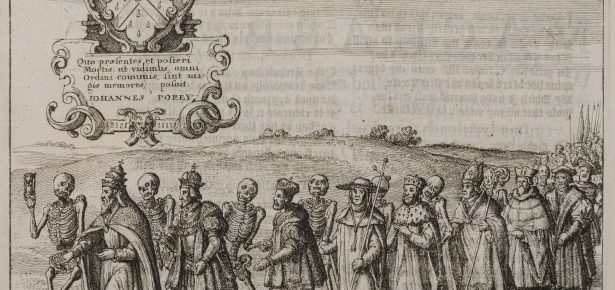
With the pandemic still looming above us, thoughts of passing away may have crossed your mind repeatedly over the last while. Those thoughts, revolving around a kernel of inert fear, most likely did not take hold for very long but were brushed aside and stifled with everyday urgent matters. Our culture, after all, tends to depersonalize death, making it easy for us to avoid reflecting upon the concrete finality and individuality of our own end. In this regard, Renaissance England could not have been more different from contemporary times. It made remembering death a daily, pressing matter, according to the Latin reminder memento mori (“remember that you must die”), which encouraged reflection upon the prospective event of one’s expiration. As with John Lydgate’s The Dance of Death, the basis for the mural that graced the north cloister of St. Paul’s Cathedral during the sixteenth century, it personalized an individual’s relationship with the Grim Reaper, a unique skeletal companion and final dance partner, enjoining all people—men, women, and children, from the peasant to the monarch—to imagine the future event of departing from the world.
The Death Arts in Renaissance England (2022), which complements our earlier volume The Memory Arts in Renaissance England (2016), presents a textual and visual record of how death was experienced as an art in the pre-modern sense of “artifice,” “craft,” and “techne.” Far from being an existential negation, death built up and enriched society. It was a doing, a making, a trafficking. The critical anthology has more than seventy carefully curated passages written by women and men that, along with over twenty images, consider a range of death arts practiced from 1500 to 1700, including not just the ars moriendi (the art of dying), but skills and activities as diverse as drafting wills, theatricalizing Roman suicide on the stage, analyzing numerical audits of plague victims, sermonizing from the pulpit, elegizing the nobility and royalty, composing and printing didactic murder ballads, speechifying on the scaffold, and so on. Through such activities, death can be found in the nooks and crannies of everyday early modern material culture and its archive. The death arts, by no means confined to the final drawing of the curtain, were conducted throughout a person’s entire lifetime from daily reflection on the self and dutiful commemoration of others, through preparatory labours and business, to dying, funeral, burial, and memorialization.
Where these arts were concerned, religio-political strife always rested close to the surface insofar as the Reformed church repudiated the Catholic doctrine of Purgatory and forbade intercessory prayers and rituals for the dead. The vibrancy and ubiquity of the death arts may in part be linked to the Protestant and humanist mobilization of the printing press, while English Catholic practices still lingered on. Death cavorted to different tunes across a range of popular genres, such as elegiac verse; devotional works; primers; moral philosophy and medical treatises; commonplace books; conduct manuals; repentance pamphlets; and narrative poetry, romance, and histories. Indeed, there were many ways of dancing with Death in the English Renaissance.
Latest Comments
Have your say!